Egypt 4: Luxor and the Nile
Today we left Cairo and Giza and headed south, up the river, to meet our cruise boat in Luxor. (If you read yesterday's post yesterday, you may notice some repetition ... this is because my brain malfunctioned and I wrote that we caught the boat in Cairo. We certainly did not. I even have photos of the Luxor airport. I can't explain it. Yesterday's post is edited, and today's contains the introduction to the Emilio Prestige...)
By the way, there was some discussion in the group about the Nile. It used to be unanimously considered the longest river in the world; the Amazon now (by some people, mostly Brazilians) is often listed as longer by less than 100 miles, but that's a bit controversial. What's not is that the Nile is much longer as the crow flies, the Amazon being extremely meandering. (At any rate, the Yangtze is certainly not.) The Nile is also not the only river that flows north. A few of the sixty other major ones: the Betwa (in India), Bighorn, Monongahela, Niagara, Orinoco, Rhine, Shenandoah, and Willamette, not to mention all the big Siberian rivers like the Lena, Ob, and Yenisei. The annual floods of the Nile are of immense importance to Egypt, which Herodotus called "the Gift of the Nile"; they created the highly fertile Nile valley in the middle of the desert.
So, in the morning we put our suitcases out and the staff picked them up. We went to the airport after breakfast and once again George got the group through security. Egypt (and Turkey when we transited Istanbul on the way home) have several layers of security; in Egypt you go though three different screenings.
Luxor airport
Once in Luxor we got onto a van and met our Luxor Bucket List rep, who made sure everything went smoothly on the boat and at the places we went in the town. Luxor has been suffering for the past few years as American tourists stayed away; everyone was glad to see us.
More globalism
As in Cairo (and everywhere), many people still get around and do their work with horses and donkeys.
A security facility
Karnak! Right smack downtown
Closer to the river
Out to the boat, the lovely Domina, which was very comfortable and staffed by friendly and efficient crew... although there was some difficulty explaining the bizarre lockboxes (which we did get figured out eventually, and which you really must use because no one in Egypt will be responsible for money, passports, or valuables that weren't locked away). The boat had two good stores - one for souvenirs and one for jewelry - and a spa with massage, as well as a sundeck with a pool. Very lovely for a cruise.
After we got settled and had lunch, we headed for Karnak Temple.
Karnak is one of the biggest temple complexes still extant. Building at the complex began during the reign of Senusret I in the Middle Kingdom and continued into the Ptolemaic (Greek) period, although most of the extant buildings date from the New Kingdom. The area around Karnak was the ancient Egyptian Ipet-isut ("The Most Selected of Places") and the main place of worship of the eighteenth dynasty Theban Triad (Amun, his wife Nut, and their son Khonsu). It is part of the monumental city of Thebes, the Greek name for Waset (the modern city of Luxor contains ancient Thebes), which was a major religious center for centuries and served as Egypt's capital beginning with the Eighteenth Dynasty.
Ram-headed sphinxes symbolized Amun
Scarab beetles moved the solar disc across the sky; they symbolized luck.
The sacred pool where priests purified objects, offerings, and themselves.
The fallen top of an obelisk
This obelisk was built by King Hatshepsut (1473 -1458 BC) (the Egyptian word for 'queen' could not mean a ruling pharaoh, and Hatshepsut was always called 'king'). It is 97 feet tall and its inscription says it took seven months to cut in the quarry; it was one of four when erected and the only one remaining. The smaller one you can see is 75 feet tall and was erected by Tuthmosis I (1504 - 1492 BC), her father.
Carvings
Nut, goddess of night and wife of Amun
Some of the remaining carved columns in the colonnade
After millennia the paint remains
Plaster on a sandstone wall
Thutmose III (step-son of Hatshepsut). Arms crossed means the statue is of a dead king; the smaller woman in the royal pose (left foot forward, arms at her side) is his wife.
Avenue of ram-headed sphinxes of Amun. Between their paws is Rameses II, portrayed as Osiris.
This is the unfinished First Pylon (the outermost wall - temples were built from the inside outwards) begun by Nectanebo I (380-362 BC)who probably built the surrounding wall. The pile of rubble was original - it's how they got those huge stones to the top of structures.
In the background we see the modern equivalent of the rubble pile.
This small alabaster sphinx is one of the few remaining from an avenue that once linked Karnak and Luxor Temples.
After visiting Karnak we rode in horse-drawn carriages for a quick tour of Luxor, ending up in a little coffee shop in a local shopping center.
Nancy and me in the carriage
Off we go!
Sunset over the Nile
Luxor Temple
Minarets. By the way, it's decidedly fictional that everything stops dead when the muezzin calls for prayer. People just keep on doing what they're doing. Our guide said you aim for five times, and you do it when you can.
As you may recall from the wedding photos I posted, Egyptian brides, at least in big cities, love their white dresses as much as American ones. There were bridal shops a-plenty.
The shop's name (Believe It No Hassle) brought laughs from the whole group.
We got coffee and tea here before going on to Luxor Temple.
The little mall
From there, as night fell, we went to Luxor Temple.
Our guide said the temple carvings were easier to see lit up at night, and the temple was beautiful. It is a later temple complex than nearby Karnak, built in approximately 1400 BC. Unlike the other temples in Thebes, Luxor temple is not dedicated to a cult god or a deified version of the king in death. Instead Luxor temple is dedicated to the rejuvenation of kingship; it may have been where many of the kings of Egypt were crowned in reality or conceptually (as in the case of Alexander the Great who claimed he was crowned at Luxor but may never have traveled south of Memphis, near modern Cairo.) To the rear of the temple are chapels built by Amenhotep III of the 18th Dynasty, and Alexander. Luxor faces south, rather than east - towards Karnak.
Here is a model of the temple complex as it probably looked when new.
Old photos of the excavation.
Part of the Avenue of Sphinxes
Isis and Osiris, symbolizing kingship
Me in the colonnade
Two complex employees
The colonnade
Amun and Mut
In the chapel Amenhotep built, a line of his captives
The Theban Triad. Once a year, at the flooding of the Nile, the barque of Amun was carried from Karnak to Luxor as part of a ceremonial renewal of kingship.
Rameses II
A column carved as papyrus
This is the door to a mosque built on the site before the temple was excavated. That door was ground-level at the time. As the lights suggest, the mosque is still used, but worshippers enter from the other side.
The wall around the temple.
Then it was back to the boat for a late supper. In the morning most of us would be up early to go hot-air ballooning over the nearby Valley of the Kings!
















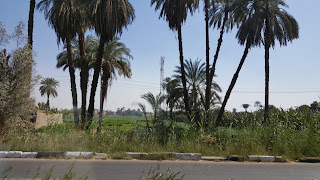






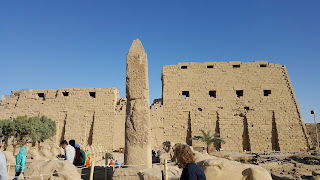





















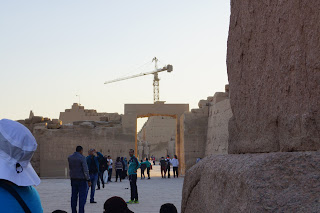



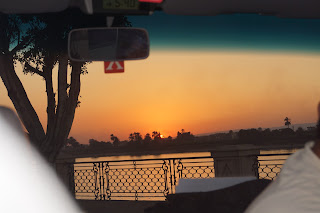







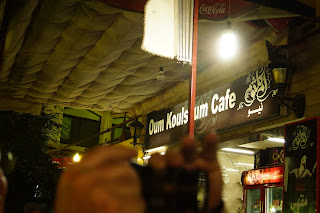










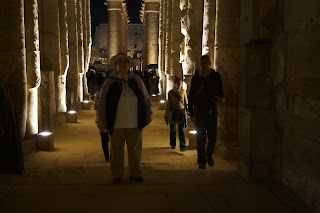















































1 Comments:
-
At 9:51 PM, March 16, 2017
 Kathie had this to say...
Kathie had this to say...
-
-
<-- Older Post ^ Home Newer Post -->The San Joaquin River in California's Central Valley flows northward to the delta in Stockton, where it meets the southward flowing Sacramento River. Whatever waters haven't been siphoned off for irrigation and Southern Californians then heads past the sloughs into San Pablo Bay, an arm of the northeast end of San Francisco Bay, and thence into the Pacific Ocean.
Post a Comment
Subscribe to Post Comments [Atom]